While there are countless project management software options available, finding a dedicated marketing management system – one that includes the specialist workflow and reporting features marketing teams need – is far more difficult.
We spent many years trying to find the right marketing management system for us and testing out multiple solutions is as expensive and time-consuming as it is frustrating. To save you going through the same struggle, we’ve put together this article to help you choose the right marketing management system the first time around.
What are we looking at in this article?
In this article, we’re taking an in-depth look at the top five marketing management software tools that we’ve used after testing hundreds of different platforms over the past five or so years.
The five tools we’re looking at in this guide are:
This article isn’t a brief recommendation list with a quick summary description and a couple of screenshots. We’re reviewing each of these platforms to assess the features on offer, the pros and cons of each platform and why you may (or may not) want to choose each one.
And, for the record, there are no affiliate links in this article – these really are the best marketing management systems we’ve used over the years.
We’ve broken this guide up into seven sections, including a review for each software platform. Here’s a summary of what we’re looking at today and you can click on the blue link text to jump ahead to any section:
- What is marketing management software? A quick definition and why this is different from other types of marketing software.
- TrueNorth review: The dedicated marketing management system (built by marketers).
- Asana review: Best for managing workloads on smaller projects.
- monday.com review: Best for managing marketing tasks.
- Infinity review: Best for collaboration and client communication.
- Wrike review: The best for real-time workflow management.
- Comparison: We compare each tool on pricing, features and usability to help you choose the ideal software for your needs.
First, we start off with a quick definition section to clarify what we mean by marketing management software and why this is different from other types of marketing software and why this isn’t the same thing as project management software.
Then we take a deep dive into the reviews for our top five systems.
Finally, we round up this article with a comparison section that stacks our five tools up against each other to see how pricing, features and usability compare.
What is marketing management software?
Marketing management software is a specialist type of software platform designed to help senior marketers manage their teams, campaigns and processes. Primarily, a marketing management system should provide marketing managers with the tools they need to perform their job effectively.
There are three key components to this:
- Campaign planning
- Campaign management
- Team management
A lot of the campaign and team management requirements can be filled by regular project management software with features like task lists, schedules, statuses and collaboration. However, this doesn’t help with the campaign planning process or many of the specialist needs marketing teams have when it comes to campaign and team management – eg: marketing analytics, optimisation, campaign approvals, etc.
In short, project management software doesn’t go far enough for marketing teams and this is why there’s a need for dedicated marketing management software.
In truth, there’s a serious lack of dedicated options for marketing teams and, even in this article, most of the recommendations are project management systems that provide a bespoke marketing management solution. The problem is, most project management software providers promise or attempt to include a specialist solution for marketing teams but, in most cases, they offer very little substance beyond a few vanity features.
This is why we’ve only got five software options in this article: because there simply aren’t enough quality options for marketing teams to recommend more than five.
Technically speaking, only one of the platforms we’re looking at today is a dedicated marketing management software solution and the rest are project management systems that have developed and integrated dedicated solutions for marketing teams over the years – and to great effect.
In modern marketing, speed is crucial for driving growth and keeping ahead of competitors.
Here at Venture Harbour, we’ve adopted agile marketing principles to identify new opportunities and respond to them quickly. In the words of PMG CEO, George Popstefanov, “agility is a superpower” that’s crucial for meeting the rapidly-changing demands of consumers in the digital age.
“The faster consumer insights can be mobilised for action, the better we become at flexing agility to meet the needs of customers in the moment.”
Agility is a superpower that goes beyond digital transformation; George Popstefanov, Think with Google
One of the biggest challenges in agile marketing is developing campaign ideas and, then, launching them quickly enough to seize new opportunities. Even with the best data systems in place, identifying opportunities before your rivals is meaningless if you can’t turn insights into marketing actions quickly.
By the time you finally get around to launching your new campaign, the opportunity has already passed or the rewards have diminished – and half of your rivals have identified the same opportunity.
Luckily, the first marketing management system we’re looking at today is designed to solve this problem.
#1: TrueNorth: The dedicated marketing management system (built by marketers)
Pricing: £70/month (all features, for any team size)
We spent years testing out marketing management software to find the right platform for our needs but we never found one system that provided everything we were looking for. Some were great for campaign planning but not so good at analytics while others excelled at task management but fell short when it came to collaborative ideation and prioritising campaign ideas.
Eventually, we realised the reason we couldn’t find the platform we were looking for was because it didn’t exist – so we built it for ourselves.
TrueNorth is the growth marketing platform that brings all of your marketing planning, campaign management and performance tracking into one system. It provides a single workspace for your team to create and develop marketing ideas so you can launch campaigns faster.
By reducing the time it takes to put ideas into action, TrueNorth helps you seize opportunities while the rewards are biggest. Meanwhile, built-in simulation and performance tracking help you prioritise campaign ideas and optimise live campaigns to maximise ROI.
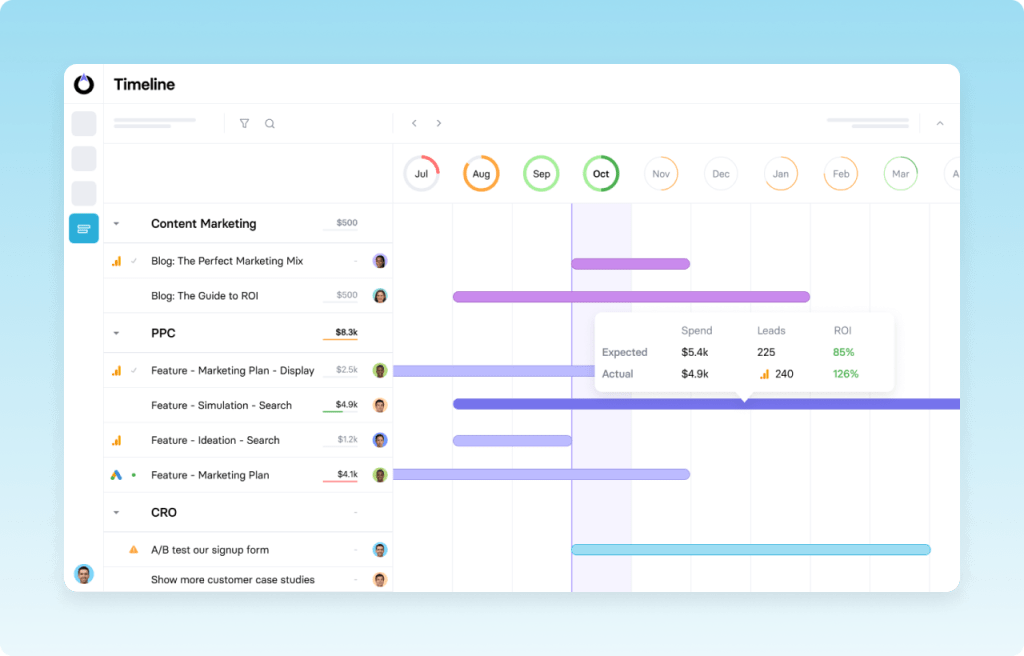
Key features:
- Campaign tracking: Stay on top of everything with a single view. All campaigns – whether running now or upcoming – across all channels.
- Growth projection: Guide your team to the right decisions with data-driven predictions.
- Campaign simulator: Predict the outcome of campaign ideas and select the best strategies.
- Milestones: Set milestones for campaigns, based on data-driven projections, and optimise campaigns to constantly hit targets.
- Campaign tracking: Measure campaign performance vs simulations, make adjustments and resimulate to identify the changes that’ll maximise performance.
- Campaign ideation: Generate winning campaign ideas faster with collaborative ideation and simulation.
- Idea capture: Collect ideas from your team outside of meetings so you’re ready to develop the strongest concepts right away.
- Prioritise ideas: Quickly prioritise strategies and campaign ideas using the Impact, Confidence and Ease (ICE) framework, backed up by your data-driven campaign simulations.
- Historical comparisons: Compare new ideas with what you’ve tried before to build new campaigns based on what really works, not just gut feeling.
- Agile analytics: The Analytics interface makes it easier than ever to adapt fast when a campaign isn’t working – or double down when it is.
TrueNorth is designed to help you hit your growth goals more effectively by cutting out inefficiencies across the three key stages of marketing:
- Planning: Create and develop winning campaign ideas faster.
- Marketing management: Set milestones and track campaigns vs projections to achieve more of your marketing goals.
- Optimisation: Use simulations, historical performance and agile analytics to maximise campaign performance and ROI.
During the planning stage, TrueNorth helps team members generate ideas individually and in groups. Managers can request ideas from team members who can brainstorm by themselves and develop ideas with teammates before they head into meetings. This means you’ve already got a log of ideas to discuss by the time you hold your first meeting, which you can discuss and narrow down into a smaller list of ideas worth developing further.
Once you’ve fleshed out your best ideas, TrueNorth’s campaign simulator puts them to the test through data-driven projections to predict their performance. This helps you identify the campaign ideas that stand the best chance of achieving your marketing goals or, possibly, even surpassing them.
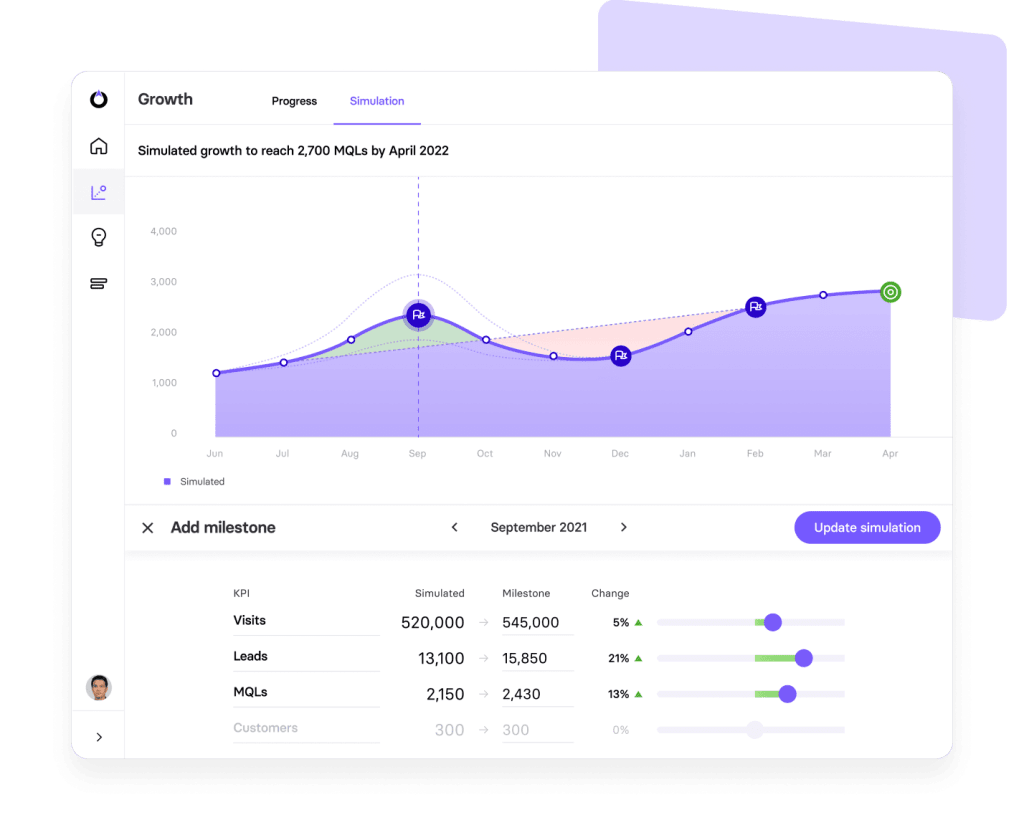
This way, you can set goals that are both achievable and ambitious enough to maximise ROI.
Once your campaigns are live, TrueNorth tracks results and you can use your simulations as a benchmark to check performance is on track. Instead of waiting days or months to see how campaigns perform, you can identify poor performance faster and take action to get results back on track.
With the campaign simulator, you can re-run projections and adjust parameters to see what needs to change to hit your targets – for example, how much additional traffic you need to generate to achieve your target revenue for the campaign.
How much does TrueNorth cost?
Unlike most marketing software tools, TrueNorth runs on a simple pricing model that gives you access to all of its features with unlimited features for a flat-rate monthly fee. This means you don’t need to worry about per-user pricing, upgrades, feature restrictions or usage limits. Instead, you pay a flat $70/month for your entire team while most of the other tools in this article are priced across multiple plans with different features and usage restrictions.
Also, you have to keep an eye out for the per-user pricing system most providers use, which multiplies your monthly software fees by every member on your team.
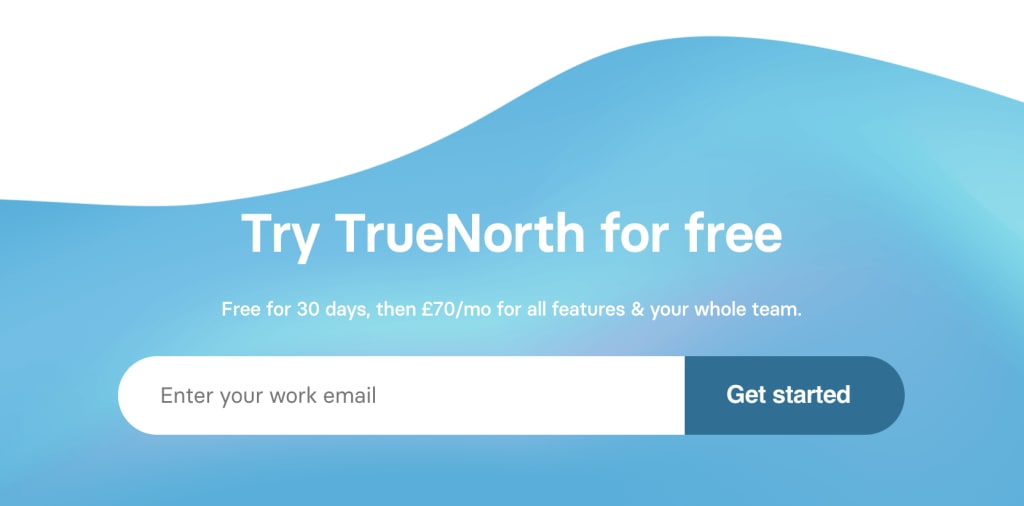
Considering TrueNorth is designed specifically for marketing teams, the fact that you’re covered for unlimited users and you’re getting access to all of its features for a flat rate makes this one of the most affordable options we’re looking at today.
Pricing aside, TrueNorth is the only system that provides several of its most advanced marketing features, such as campaign simulation, growth forecasting, meeting-less ideation and more.
What is TrueNorth good for?
TrueNorth is designed to help you achieve your marketing goal faster and more often. Reducing the time it takes to create and deploy winning campaign ideas was a priority for us when designing TrueNorth. This is why we implemented meeting-less ideation to help your team come up with ideas before the first meeting. The system also helps you prioritise campaign ideas by simulating performance and identifying the strategies that will make the strongest positive impact.
The campaign simulator helps you choose campaign ideas and judge performance with confidence, using projections as a benchmark. This helps you identify issues faster or see where campaigns are overachieving so you can adjust your budget to take full advantage of every opportunity.
Usability is also important with any software of this nature. We’ve worked hard to implement lightweight collaboration features so that teammates can work together when needed – without interrupting each others’ workflow.
A common problem with marketing management software (and a lot of business software, in general) is that features or poor UI design cause more problems than they solve. We all know what it’s like to get inundated with Slack notifications or use those software tools where it takes half a dozen clicks to find a tool or complete a simple task.
This is something we care about a lot at VentureHarbour so we’ve tested, optimised and revised TrueNorth through several development stages to deliver powerful features in a lightweight UI – one that knows when to get out of your way.
What is TrueNorth missing?
Most of the software platforms featured in this article include a lot of project and task management features but TrueNorth keeps things simple in this regard. Instead of focusing on tasks, we decided to focus on goals, objectives and results so we’ve taken a light approach to task management with TrueNorth.
Managers can assign tasks, request ideas from team members and create campaign timelines but we’ve left out a lot of the settings and advanced features you’ll find in dedicated project management systems. This is because we want you to focus on hitting targets, not constantly changing settings and moving tasks around in our software.
We believe this is the right approach to take with marketing management software but we understand some companies may require a system that includes more project management features – and we’ve got some great recommendations in this article, if that’s what you’re looking for.
TrueNorth pros & cons
TrueNorth pros
- Built for marketers by marketers: TrueNorth is the only dedicated marketing management software we’re aware of that’s built specifically for marketers, by marketers.
- Campaign simulator: TrueNorth’s innovative campaign simulator helps you prioritise campaign ideas, choose the best creatives and optimise performance with greater precision.
- Simple pricing: For £70/month, you get access to all of TrueNorth’s features for your entire team – no hidden fees, user-based pricing or upgrade expenses.
- Usability: TrueNorth is optimised to help you launch and optimise campaigns faster without spending unnecessary time fiddling with features and settings in the software.
TrueNorth cons
- Marketing focus: If you’re primarily looking for a project management system that moonlights as marketing management software, the other options in this list may be more suitable.
- No free plan: As part of TrueNorth’s simple, flat-rate pricing model, there’s no free plan available (but you can try it for 30 days, for free).
TrueNorth verdict
TrueNorth is the only marketing management system designed to help you achieve goals faster by removing delays in developing ideas, launching campaigns and optimising performance faster. With meeting-less ideation and lightweight collaboration, you can develop winning campaign ideas without the long-winded creative sessions while TrueNorth’s innovative campaign simulator helps you choose the best marketing ideas, based on data rather than assumption.
This data-driven approach means you can choose campaign ideas with greater confidence and prioritise the marketing actions expected to have the strongest positive impact, putting your budget to the best possible use.
The simulator also provides performance benchmarks that you can use to identify under/overperforming campaigns faster, instead of waiting days, weeks or months to intervene. As soon as performance deviates from projections, you can step in and identify what’s going on, re-run simulations to explore your options and test changes to maximise ROI.
If you’re looking for a marketing management system that helps you launch marketing campaigns and achieve goals faster, TrueNorth is the only platform of its kind currently available.
#2: Asana: Best for managing workloads on smaller projects
Free plan available; paid plans start from £9.49/month
Asana is a project management system designed to help you manage workloads and increase productivity by simplifying processes. The company provides a dedicated solution for marketing managers to create plans, manage campaigns and streamline creative production although the emphasis remains on task management more than marketing activities specifically.
The system is designed primarily for project managers who need to approve tasks, assign them to individuals or teams and manage schedules/plans to ensure you complete projects and goals on time.
Asana is a great tool for marketing managers who like to plan every task and map out workloads to ensure everyone on the team is putting their time to the best use without overlapping personnel or resources. This is the key role Asana wants to play and it doesn’t offer so much in terms of collaboration features and it doesn’t even try to include campaign reporting or specialist marketing management features.
However, it does (for the most part) do the job it’s designed for very well and excellent integration options mean you can expand functionality through third-party tools – although some notable names are missing.
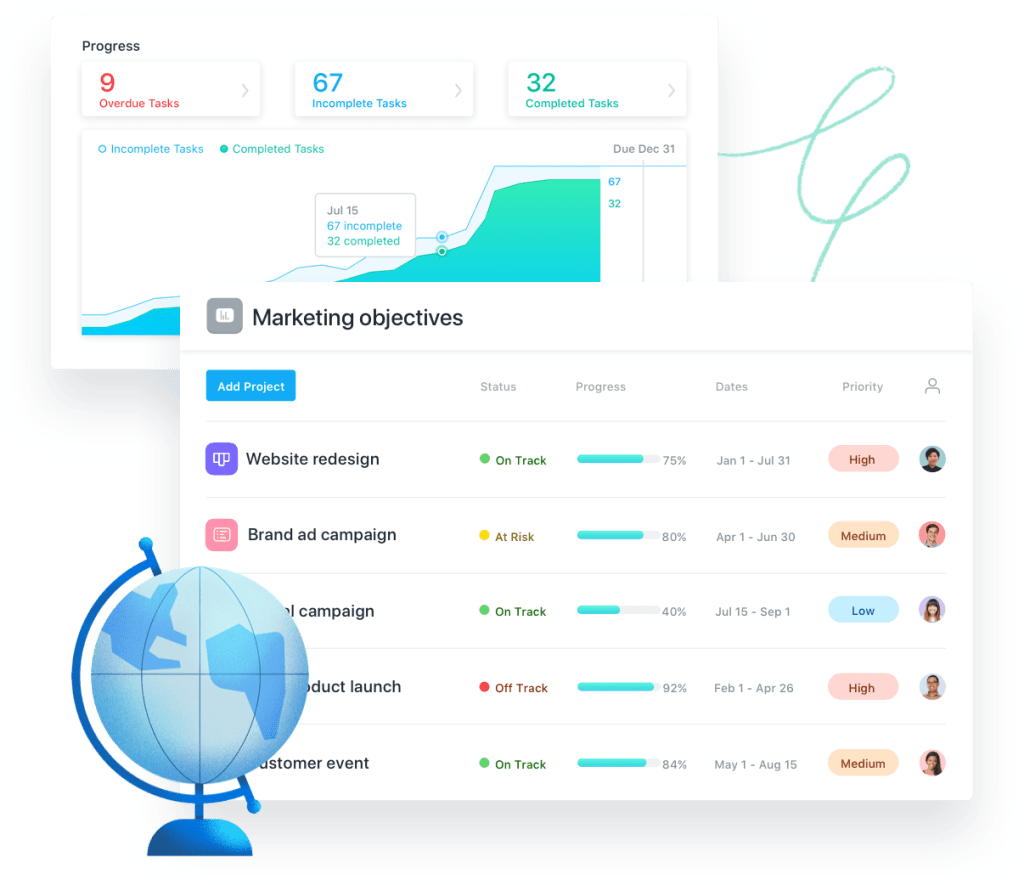
Key features:
- Project management: Asana’s project management systems caters well for marketing campaign management.
- Timelines: visualise project plans to see the relationship between tasks and keep projects on track—even when plans change.
- Task management: Manage tasks, assign them to team members and keep track of progress throughout the project.
- Workload management: Manage the workload of individuals throughout the project and reassign tasks where necessary.
- Creative requests: Request ideas, set up collaboration sessions and approve concepts within Asana.
- Feedback: Give clear feedback by leaving comments directly on images or PDFs that turn into tasks for easy tracking.
- Automation: Add rules to automate manual processes like planning, assigning tasks, updating Asana fields, and more.
- Project views: Manage and track projects in three different view formats: Lists, Timeline and Boards.
- Project templates: Use and create project templates to speed up the planning and early management stages.
With Asana, you’re essentially using a project management system to plan marketing campaigns and manage the tasks involved in running them. This is a very different tool compared to TrueNorth, which offers dedicated features to help your team come up with better campaign ideas. Asana simply allows you to schedule meetings and assign tasks to individuals although it does give you significantly greater control over tasks and workflows.
The truth is, Asana isn’t really designed for streamlining marketing processes specifically, even if the marketing teams page on its website gives you this impression. This platform is all about streamlining team workflows – both at the team and individual level – and this is a key component of any project, marketing planning and campaign management included.
In this way, Asana will help you manage marketing campaigns more effectively but it has its limitations beyond task management.
How much does Asana cost?
Asana offers a generous free forever plan that allows you to manage unlimited tasks and projects and team members to send unlimited messages to each other. You also get unlimited activity log and unlimited storage space while up to 15 team members can use the free plan to collaborate on tasks – although collaboration features are limited to file sharing, messaging, task managing and other basics.
Even still, that’s an impressive offering for a free plan, considering you’re covered for up to 15 team members and unlimited projects.
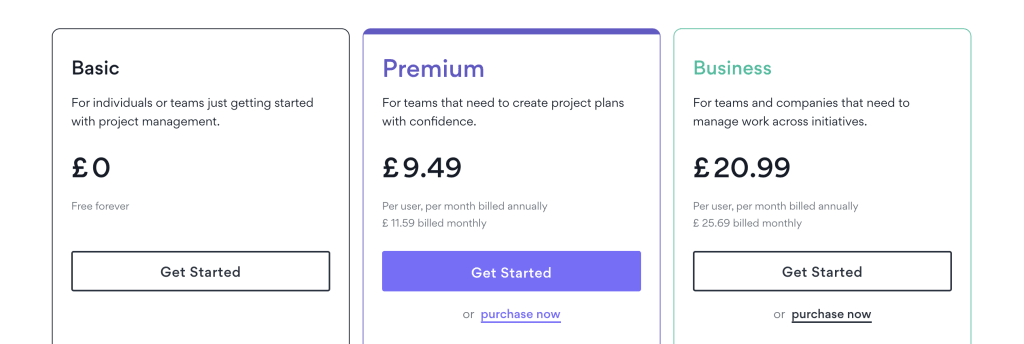
Paid plans start from £9.49/month per user with the Premium plan unlocking Asana’s Timeline feature, which we found to be its best project management tool. The Timeline allows you to create project plans by mapping out the workloads of team members to avoid conflicts over burnout. You can make sure every task is given ample time for completion and ensure the required personnel and resources are available at the right time.
This visual tool is a great way to manage complex workloads, especially in dynamic scenarios where new tasks need fitting into projects or certain tasks are reprioritised. The Timeline tool helps you move things around, create space and rearrange workloads so you can maximise the productivity of your team without burning anyone out.
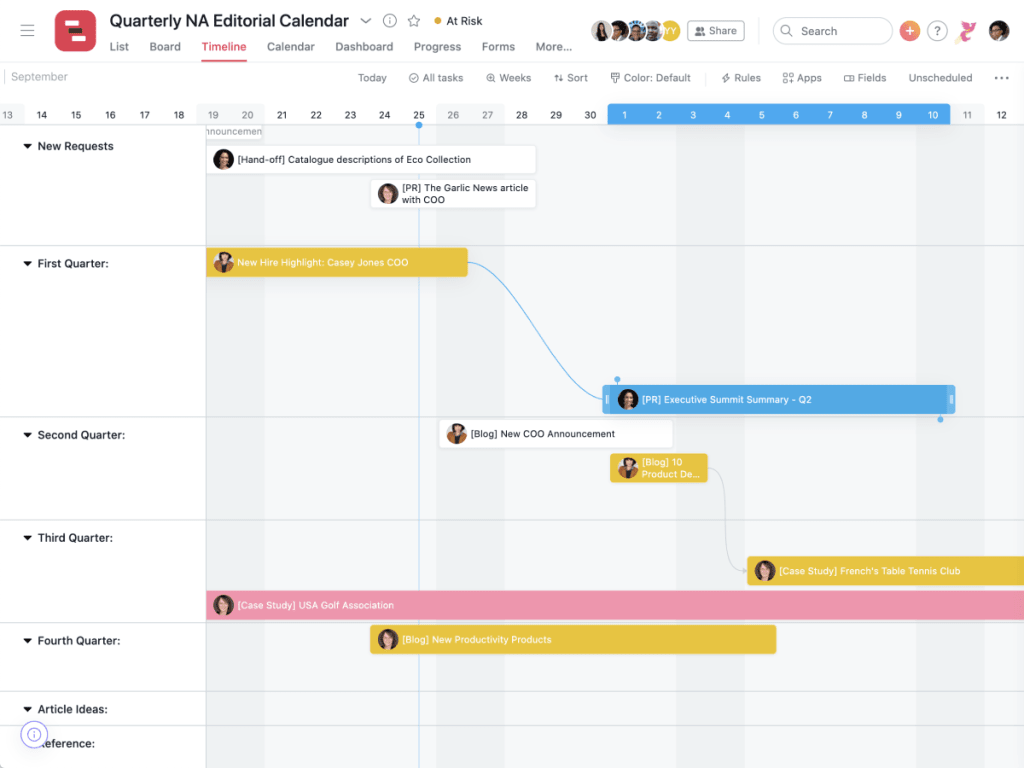
The Premium plan also gets you unlimited dashboards, advanced search, basic automation features and task templates – among other things.
The Business plan costs £20.99/month per user, allowing you to set and track goals on projects, create custom automation rules, approve tasks and manage workloads with greater control. You can find more details about pricing and the features available on each plan by visiting the pricing page on Asana’s website.
What is Asana good for?
I’ve already spoiled the surprise but the fact is Asana is designed to do one thing really well: project management with all the emphasises being on task and workload management. If your approach to managing campaigns is equally focused on workloads, then Asana is a capable platform, as long as you’re willing to accept its limitations.
Asana deserves credit for the generous offering on its free forever plan, too, which covers you for unlimited projects, tasks, storage space, activity log and plenty of other features. That being said, the company is clever with the features it reserves for paid plans – for example, the timeline and advanced search only available on Premium and higher or the goals and advanced workflow management features only available on the Business plan.
As a result, the free forever plan is both surprisingly generous but deceptively restrictive because you have to sign up for the paid plans to access a few key features that unlock the best of Asana’s single purpose: project management.
What is Asana missing?
Asana excels at workload management but it does lack in a few areas if you’re looking to use it as a marketing management system. Namely, the platform doesn’t have any built-in features for planning, running or optimising campaigns. You can manage these processes by creating projects and tasks in Asana but you have to physically perform all of these processes elsewhere.
This focus on task management is evident in Asana’s reporting features, which visualise the performance of your team. However, the system only has access to productivity data available within the software so, even if you create a “Marketing Dashboard,” you’re essentially compiling a progress report on marketing activities without access to any campaign performance metrics.
Annoyingly, integrations are a big strength of Asana but the lack of a native Google Analytics integration is particularly frustrating. Thankfully, you can link the two systems using Zapier but you only get limited integration and it’s another tool you have to bring into the mix.
Asana pros & cons
Asana pros
- Project management: Asana helps you manage a diverse range of projects, including marketing tasks throughout your campaigns.
- Team management: Asana excels at workload management for teams and individuals.
- Documentation: Asana has a great library of online documentation to help you implement and use the system.
Asana cons
- Task management: Tasks and subtasks can get lost among the pack, especially on larger projects.
- Onboarding: Long setup process requires quite a lot of manual input to implement workflows, templates, etc.
- Email notifications: By default, Asana floods your inbox with notifications and, while you can apply settings to reduce these, a lack of control options means it’s a bit all or nothing.
- Reporting: Asana provides decent task reports but no native campaign reporting features and the lack of a Google Analytics integration is frustrating.
Asana verdict
Asana is one of the biggest names in project management software and it’s capable of moonlighting as a marketing management system, too. If you’re looking for a flexible platform for managing workflows across a variety of projects (marketing campaigns, product design, process development, etc.), then Asana is flexible enough to tick all of these boxes while also providing the core essentials for marketing management.
If you’re looking for advanced campaign planning, management and optimisation features, though, you’ll probably want to consider one of the other tools in this list.
#3: monday.com: Best for managing marketing tasks
Free plan available; paid plans start from £21/month*
Like Asana, monday.com is a project management system but it offers a greater depth of features for marketing teams. Most importantly, monday.com supports campaign tracking and templates for campaign planning, content calendars and asset management to help you plan and launch campaigns faster.
In fact, monday.com describes its Pro plan as “a complete marketing platform to manage your marketing and creative processes from A-Z with powerful tools, visualizations and automation”.
The company also offers a free Individual plan for up to two members, providing the basic essentials for project management. However, marketing teams will be more interested in the Standard and Pro plans which offer the more advanced set of features for managing campaigns and marketing tasks. With these plans, you get a comparable system to Asana in terms of project management but significantly more tools to help you plan and execute campaigns.
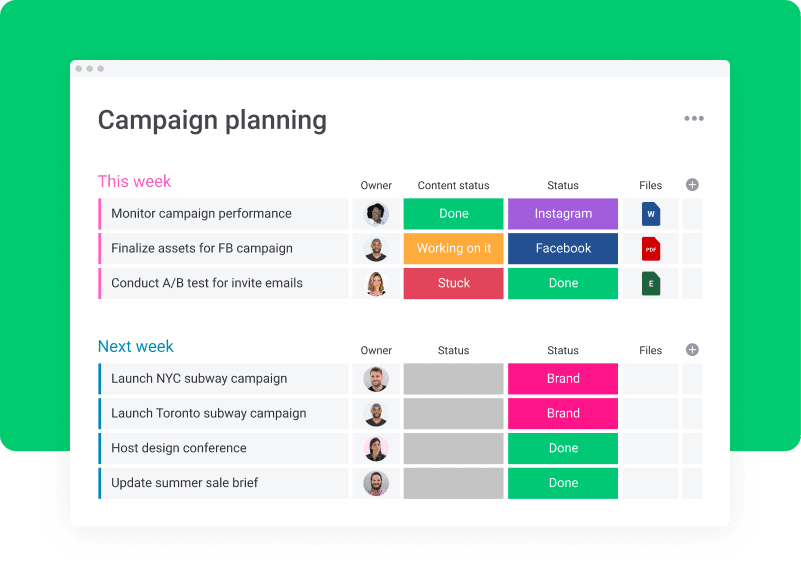
Key features:
- Project management: Manage projects, including marketing campaigns, product launches and more.
- Campaign planning: Plan your marketing campaigns in one organised workspace.
- Task management: Manage tasks at the team and individual levels throughout your campaigns.
- Advanced views: View and manage projects across multiple views, including Kanban, timeline, calendar, Gantt, map view and more.
- Content calendar: From digital publications to social media–manage your publishing schedules and coordinate all content initiatives in one visual calendar.
- Automation: Automate repetitive work by setting customisable actions in your boards.
- Performance insights: Visualise project performance and workflows so you know what’s working and what’s not.
- Time tracking: Track and monitor the time spent on each task.
- Templates: Use and create project templates to get things moving faster.
While Asana is clearly designed for project managers, monday.com makes more of an effort to cater for team members to manage their own workloads and collaborate on tasks. Managers can create tasks, assign them to individuals or teams and prioritise tasks while team members update the statuses of items as they make progress.
The default view is a table/list interface loosely based on the classic spreadsheet layout where you can add columns for time tracking, numbers, locations, progress tracking and formulas, depending on the features available in your plan.
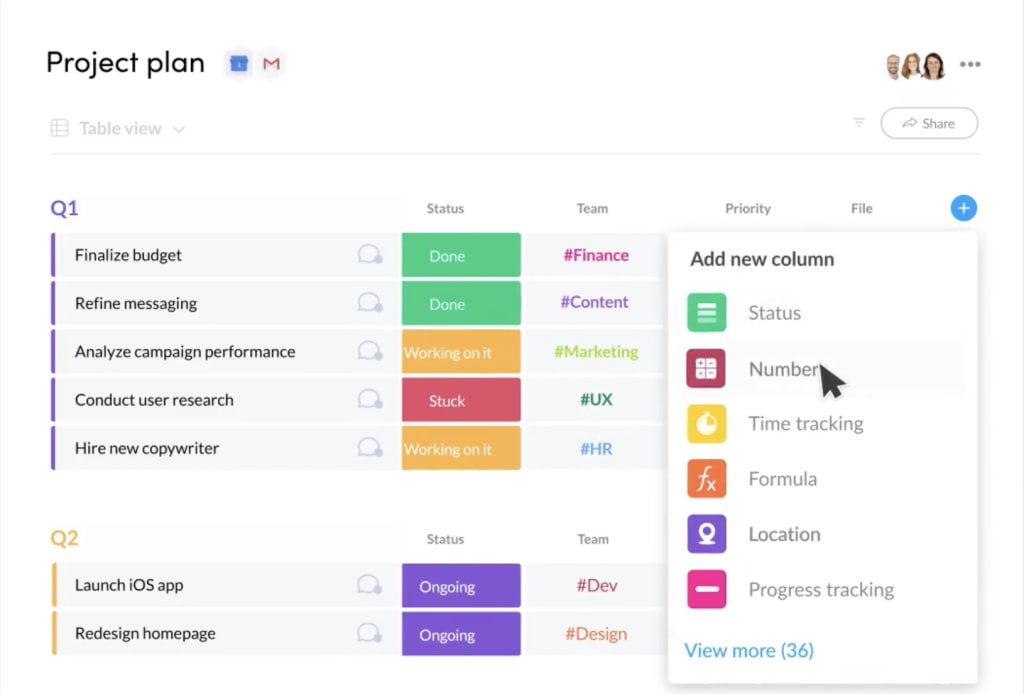
You can also switch to multiple views, including the Timeline, Kanban, Chart and Calendar views (again, some views are limited to certain plans). The Timeline view makes it easy to map out team workloads of entire projects to make sure there’s enough time to complete each task. The Timeline view in monday.com isn’t as sophisticated as Asana’s but it’s effective enough and the Table view gives you and team members greater control over task management.
Asana’s interface is also more intuitive and managing tasks involves fewer clicks compared to monday.com, which requires you to be more involved in the software. For example, when you’re creating a content schedule in monday.com, assigning tasks, setting deadlines, adding statuses and editing columns for each task can feel cumbersome.
Thankfully, monday.com has an excellent library of templates ready for you to edit for projects including campaign management, content calendars and plenty more. Built-in automation features on the Standard and higher plans also cut out the repetition of managing tasks. For example, you can create an automation recipe that automatically starts timing tasks once a team member changes the status to “Started” and ends when they change the status to “Done”.
How much does monday.com cost?
As mentioned above, monday.com offers a free Individual plan for up to two users, which gives you the basics for managing workloads across unlimited boards and documents and access to 200+ templates. Marketing teams aren’t going to get any joy out of this free plan, though, so you’ll need to sign up for a paid plan to access dedicated features for marketing management.
Paid plans start at £7/month per user for a minimum of free seats so you’re paying at least £21/month for the Basic plan. On paid monday.com plans, you can invite unlimited users into your projects on a view-only basis, which is great if you outsource tasks to agencies or freelancers – the only limitation is they can’t interact with projects, such as changing statuses on the tasks assigned to them.
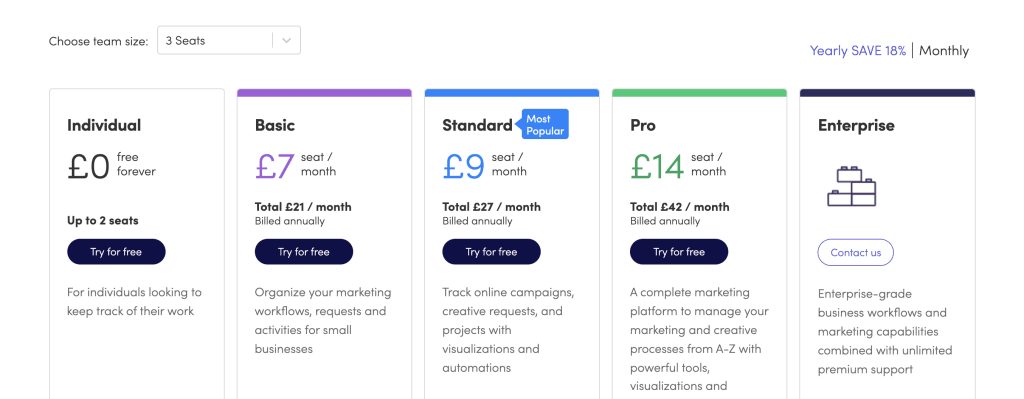
In truth, you’ll want to sign up for the Standard plan as a minimum, which starts at £9/month per user and gives you access to the Timeline, Gantt and Calendar views, guest access that allows free users to interact with projects through your account although you’re limited to a maximum of four guests on this plan and they’re billed as one seat.
On the Standard plan, you also get up to 250 actions per month for automation recipes and integrations.
For smaller marketing teams, the Standard plan may offer everything you need although larger teams or more complex projects will benefit from the features reserved for the Pro plan: Time tracking, Workload view, Chart view, Formula column and up to 250,000 actions per month for automation and integrations.
The Pro plan costs £14/month per seat/user and you can also invite unlimited guests into projects.
Finally, the Enterprise plan is priced on application and gives you advanced reporting and analytics, custom onboarding, premium support, advanced security features and advanced automation and integration options.
What is monday.com good for?
If you’re looking for a project management system that offers dedicated features for planning and running marketing campaigns, monday.com is a solid option. While Asana focuses on workload management for project leaders, monday.com aims to provide a platform for managers and team members to boost productivity across task-heavy projects.
As long as you’re happy with the pricing of the Standard and Pro plans, you can get access to the platform’s best features for marketing teams. The only catch is the per-user pricing model, which can get expensive for larger teams. Keep in mind, you can invite guests on the Standard and Pro plans and it’s worth getting a quote for the Enterprise plan if you’ve got a large team.
What is monday.com missing?
The big obvious feature missing in monday.com is an internal chat system for instant messaging within the platform. This is a standard feature with Asana and you can send unlimited messages, even on the free plan, but there’s no hint of this coming to monday.com any time soon. On the plus side, monday.com comes with a native integration for Slack, which isn’t as intuitive as having a built-in messaging system – if this is important to you.
To be honest, I prefer the commenting system in monday.com to instant messaging and all of the distractions it can cause.
Also, the interface in monday.com forces you to spend quite a lot of time in the software and some basic tasks feel overly time-consuming. When I’ve got a deadline at the end of the day, the last thing I want to do is edit a bunch of statuses and attach files that could be automatically shared elsewhere.
Another thing I’ve noticed is you can’t modify the structure of boards or tasks once you’ve created them, which is frustrating in dynamic environments where changes are guaranteed.
monday.com pros & cons
monday.com pros
- Task management: Monday prioritises task management, building your projects around individual task lists.
- Visual simplicity: The interface is a little harsh on the eyes but its visual simplicity communicates information effectively.
- Collaboration: The in-app notes, messaging and notification system aids collaboration without being intrusive on individual workflows.
monday.com cons
- Time-consuming: While monday.com is excellent for task management, you spend a lot of time creating task lists, structuring projects and updating statuses.
- Modifications: You can’t modify the structure of boards or tasks after creating them – for example, regrouping tasks or reassigning them as subtasks.
- Complicated pricing: The monthly prices displayed on the website are a little misleading because you have to pay for a minimum of three users and the per-user pricing multiplies the total fee.
monday.com verdict
There’s a lot to like about monday.com for marketing teams looking for a project management system with plenty of built-in features for planning and running campaigns. Advanced project views help you manage workloads while marketing templates speed up the planning process and automation recipes cut out repetitive tasks.
The guest system built into monday.com is an excellent collaboration feature for remote teams or companies working with external talent on projects.
The interface is intuitive enough but it does hog more time than it could on the task management side of things, especially when it comes to updating statuses and managing tasks on ongoing projects. Also, make sure you know what you’re getting into with the pricing because your fees multiply with every paid user – although you may be able to offset some of this with guest access.
#4: Infinity: Best for collaboration & client communication
Pricing: From $9/month (per user)
Infinity is a smaller name than the likes of Asana and monday.com but it offers a more advanced set of marketing management features than both of them. We’re still talking about a project management system (unlike TureNorth) that can double as marketing management software but Infinity’s reporting features are a leap ahead of anything available through Asana and monday.com.
Infinity also offers up a library of marketing management templates for planning campaigns and common processes, including campaign plans, content calendars, onboarding, social media tracking and more.
Collaboration is another big strength for Infinity with in-app messaging, mentions, share boards, invites, activity logs and plenty of other features to help your team work together more effectively from any location. You can also invite clients to your boards, share items via links, request feedback and get projects signed off faster. This is why we’re calling Infinity the best system for collaboration and communication with clients.
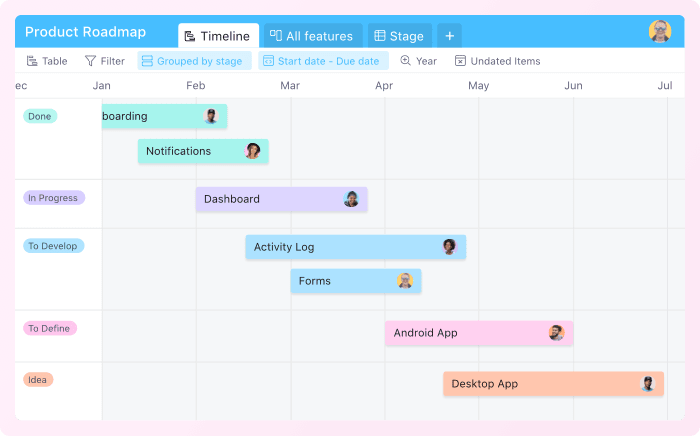
Key features:
- Campaign management: Set goals, plan campaigns and manage workloads.
- Campaign tracking: Measure important KPIs and metrics – conversion rates, sales numbers, content assignments, and anything else related to your marketing efforts.
- Project views: Use Columns, Calendar, Gantt, Table, and List views to visualise your data the way you want.
- Attributes: Build your own dashboards with the data you need and nothing else.
- Marketing templates: A library of templates for marketing management, social media tracking, marketing plans and more.
- Collaboration: Invite, assign, comment, share, mention and collaborate on tasks with ease.
- Client communication: Invite clients to your boards, share files, request feedback and keep them involved in your projects.
- Activity log: Track all changes that happen on the board and item level.
- Automation: Automate recurring tasks, set reminders and create custom automations.
Infinity offers up most of the project management features available on Asana and monday.com and even goes a step further in some areas, such as the quantity of project views provided. You can manage projects in six different views: Table, Columns, List, Calendar, Gantt and Gallery, as well as interfaces for custom forms and editing documents.
You’ve also got 19 attributes to work with in your plans, including dates, labels, checkboxes, text, checklists, links, progress and a dozen more.
Infinity also delivers some of the best collaboration features we’ve seen among our tools today and the only big feature missing is in-app instant messaging. However, the platform has a built-in commenting system and notifications that come as close to instant messaging as you could get.
In fact, I would argue the commenting system is more productive than instant chat because it’s less invasive and I, personally, prefer to turn off most of the notifications so I can crack on with work unless anything crucial is flagged up.
How much does Infinity cost?
Infinity is currently running a one-time payment promotion which means you can get lifetime access to the entire platform and all of its features for a single payment of $149. This covers you for five team members and 25GB of storage space but you can raise these limits by further increments of five users and 25GB, each one adding another $100 to the one-time fee.
So $249 covers you for 10 team members and 50GB of storage space while $349 covers you for 15 members and 75GB storage – and so on.
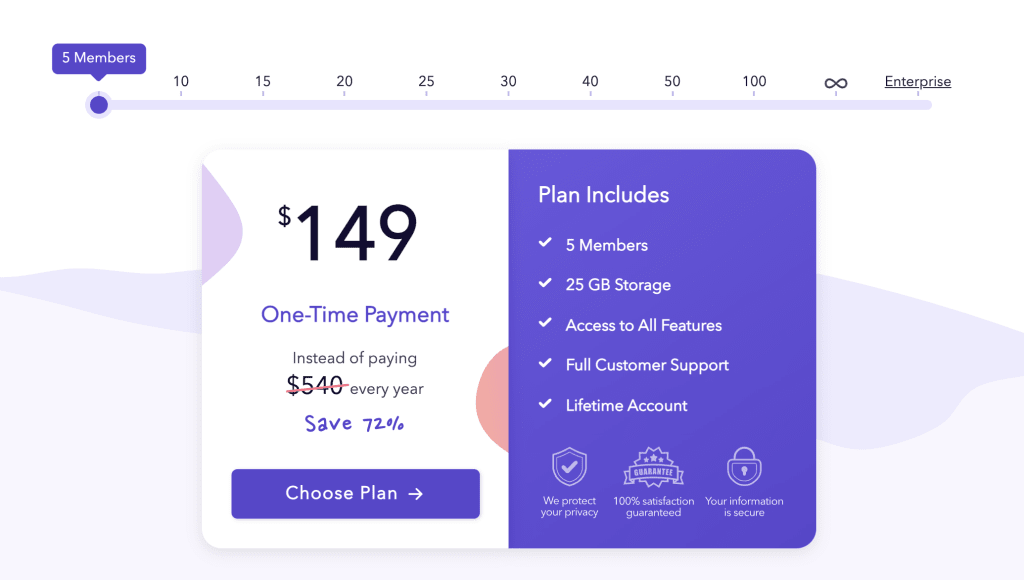
Infinity normally runs a subscription pricing model with plans starting from $9/month per user, which would cost you $540 per year for five users. You also wouldn’t get access to all features on the subscription model although you can choose exactly how many team members you pay for.
Even still, the one-time payment promotion is a big money saver at every price point and the only real downside is there’s no free trial currently available, which forces you to take a leap of faith with the software. However, it does offer a 30-day money-back guarantee, which gives you a decent window to test the system out and decide whether it’s suitable.
What is Infinity good for?
Infinity is a highly-customisable project management system that gives you control over how your data is presented. You can use attributes to build dashboards to your needs, group data into columns, create custom filters and customise almost everything. You can also edit dashboards and reports after creating them, which is a huge feature – for example, you can reorder elements and select multiple items to edit and organise in bulk.
The platform also gives you extensive control over organising and viewing projects in boards, folders, and subfolders, tabs and individual items/tasks – plus, five different project views, document views, a gallery view for browsing multiple docs/attachments and custom forms.
If you’re looking for full customizability and control over how your projects are visualised, Infinity is difficult to beat.
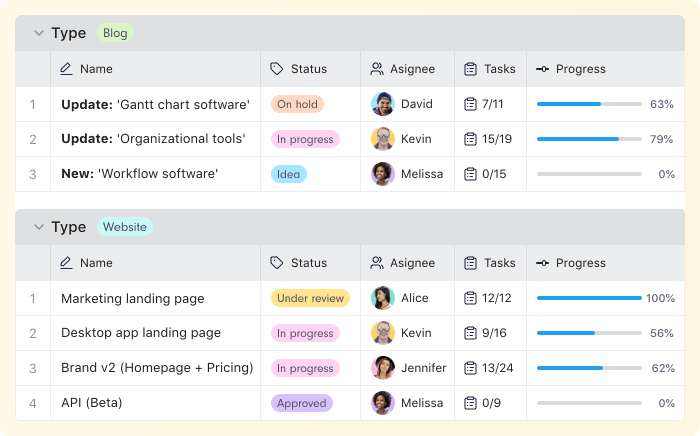
Collaboration is another area where Infinity stands out and it offers some of the best features we’ve seen for marketing teams to collaborate on projects. However, it’s the first platform we’ve seen today that provides dedicated features for collaborating directly with clients.
You can invite clients into boards, collaborate with them on tasks or simply share assets via links, including view-only options if you’re not interested in collaborating directly. Getting feedback from clients, colleagues and external talent is a breeze and only monday.com really competes here with its invitation system, provided you’re signed up for the right plan.
What is Infinity missing?
Infinity is a relatively new software product and it’s evident from using the system that certain aspects need refining. In fact, TrueNorth is the only product in this list that’s newer than Infinity but TrueNorth was developed as an internal tool over a longer period of time and, then, optimised for public release. Obviously, we don’t know the development process behind Infinity but there are some minor UX quirks that are typical of products in the early stages of release where the company needs user numbers and testing data to grow so it can iron out some of the creases.
We’re talking about minor issues here, though – things like selecting multiple items taking more clicks than it could or certain features being restricted to the account owner that probably should be available for team members. The biggest issue we encountered is navigating between different projects, which is more cumbersome than it could be, but tolerable once you figure it out.
For the most part, Infinity delivers a solid user experience, especially for a platform that gives you as much control over customisation.
On a related note, Infinity currently has quite a lot of unreleased features on its roadmaps and, while few of them are deal-breakers, there are a couple that feel like big misses – eg: team reports and some missing integrations (Slack, Google Drive, Dropbox, etc.).
The good news is Infinity is working hard to improve its software and there’s already so much to like about it that we’re excited to see where it stands in the near future.
Infinity pros & cons
Infinity pros
- Marketing management: Despite not being a dedicated marketing management system, Infinity’s flexibility and several marketing management features make it a capable option.
- Collaboration: Infinity is great if you want an all-in-one system for team collaboration and client communication.
- Flexibility: With attributes, you can build dashboards to your needs without anything unecessary getting in the way.
- One-off fee: At the time of writing, Infinity is offering a one-off fee promotion that’s both simple and affordable.
Infinity cons
- Navigational issues: Some minor navigational issues when switching between boards or projects.
- Maturity: Infinity is a relatively new product and it shows in the features and UX, which will likely continue to improve with time
Infinity verdict
Infinity is a great project management system for marketing teams that want maximum flexibility and some of the best collaboration features we’ve seen in this article. The platform offers plenty of tools and features to double up as a marketing management system, too, including data imports for campaign tracking, marketing templates for planning campaigns faster and some useful automation features for cutting down the time you spend on repetitive tasks.
Considering how much freedom Infinity gives you to customise project views and data, usability is impressive and the learning curve is reasonable. That being said, there are some UX quirks and a few big features still on the roadmap but the platform still earns a place in our top five recommendations and it’s only going to improve as the system matures.
Aside from that, Infinity offers up some features that none of the other products in this article provide – particularly when it comes to collaboration and customisation options. If you’re looking for a system to manage a diverse range of marketing campaigns and other projects, the freedom of customisation available on Infinity becomes a big selling point. Likewise, if your team members regularly need to collaborate with clients or get feedback before cleaning items to the next stage of a project, Infinity
#5: Wrike: The best for real-time workflow management
Free plan available; paid plans start from $9.80/month (per user)
Wrike describes itself as a “work management platform” designed for agile enterprises and the company offers a dedicated solution for marketing and creative teams. If you’re simply looking for a project management system, Wrike provides a generous free plan and an affordable entry plan for professionals and small teams.
If you’re looking for a dedicated marketing management system, Wrike also offers a plan that packs plenty of advanced features – including campaign reporting, collaboration features, workload management, automatic approvals and plenty more. The only downside is you have to be ready to pay enterprise-level prices to gain access to these specialist features for marketing teams.
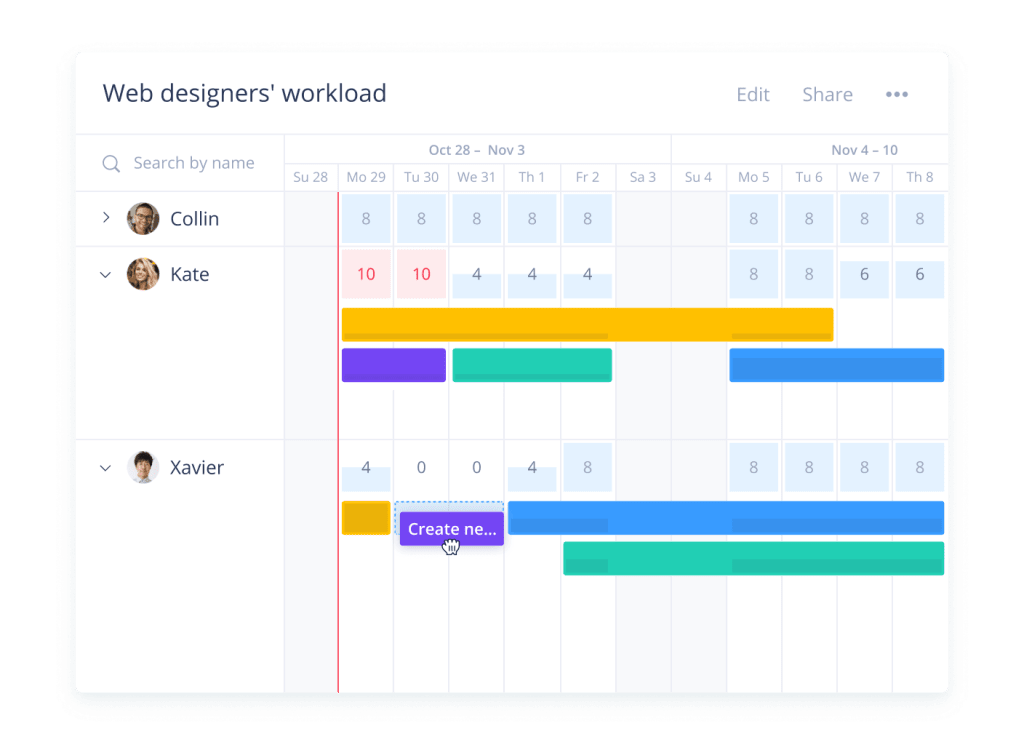
Key features:
- Live activity stream: Real-time activity management at the global, project and task levels.
- Interactive boards: View workloads in Kanban boards, spreadsheets and tables.
- Interactive Gantt charts: Easily schedule and visualise project plans and deadlines with a simple drag-and-drop interface.
- Custom workflows: Build customised workflow stages for projects and campaigns.
- Resource management: Ensure the right resources are available for each campaign.
- Real-time reports: Track campaigns in real-time and build custom reports from scratch or using built-in templates.
- Time tracking: Track the time spent on tasks and automatically produce timesheets for activities and workloads.
- Automation Engine: Automate repetitive tasks with trigger actions and responses.
- Campaign templates: Launch campaigns faster, using templates, and edit them to meet your own requirements.
If money is no object, Wrike’s specialist plan for “marketing and creative teams” is the closest thing to a complete project management and marketing management system that we’re looking at in this article. That being said, it still lacks some of the more advanced features available on TrueNorth, which is the only platform specifically designed for marketing management and nothing else.
At the end of the day, Wrike is still a project management system at heart but the company goes further than anyone else at pushing into marketing territory – as long as you’re willing to pay up for the right plan.
How much does Wrike cost?
Wrike’s pricing system is the most complex one we’re looking at in this article, especially as we’re focusing on marketing management features.
The company offers a free plan and paid plans start from $9/month per user but the advanced marketing features are only available on the “Marketing and creative teams” plan, which is basically an adapted version of the Enterprise plan and priced on application.
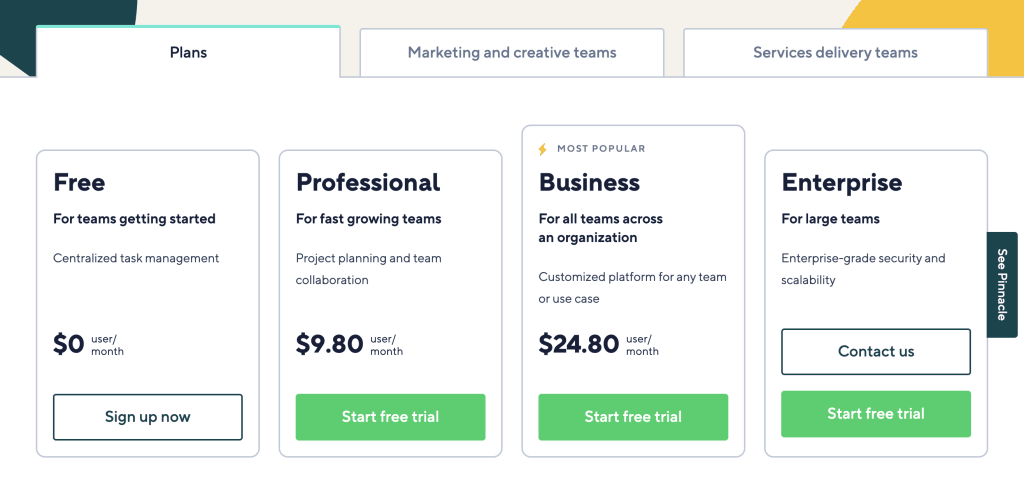
So you can forget about free plans and any of the pricing listed above if you want the best of Wrike’s features for marketing and creative teams.
Unfortunately, it wouldn’t be fair for us to disclose the pricing of Wrike’s plan for marketing teams and, even if it did, it wouldn’t necessarily be accurate because it’s priced on application. What we can tell you is the plan included all of the features available on Wrike’s Enterprise plan, plus the following specialist features for marketing and creative teams:
- Wrike Extension for Adobe Creative Cloud
- Interactive proofing for 30+ file formats across all file types (image, files, video, HTML, SharePoint)
- Visual markups and real-time threaded conversations
- Side-by-side and overlay asset comparison
- Automated multi-level approvals
- External stakeholder (guest) approvals
- Tailored marketing templates, pre-built dashboards, and advanced reporting & data visualisations
- Digital asset management (DAM) integrations
- Advanced resource management and capacity management
- Marketo, Salesforce + over 400 integrations (Available as Add-On)
- First-of-its-kind instant cross-channel campaign performance insights (Available as Add-On)
The big clue here is that you’re getting a lot more than the standard Enterprise plan offers and you should expect Wrike for Marketing Teams to be priced accordingly.
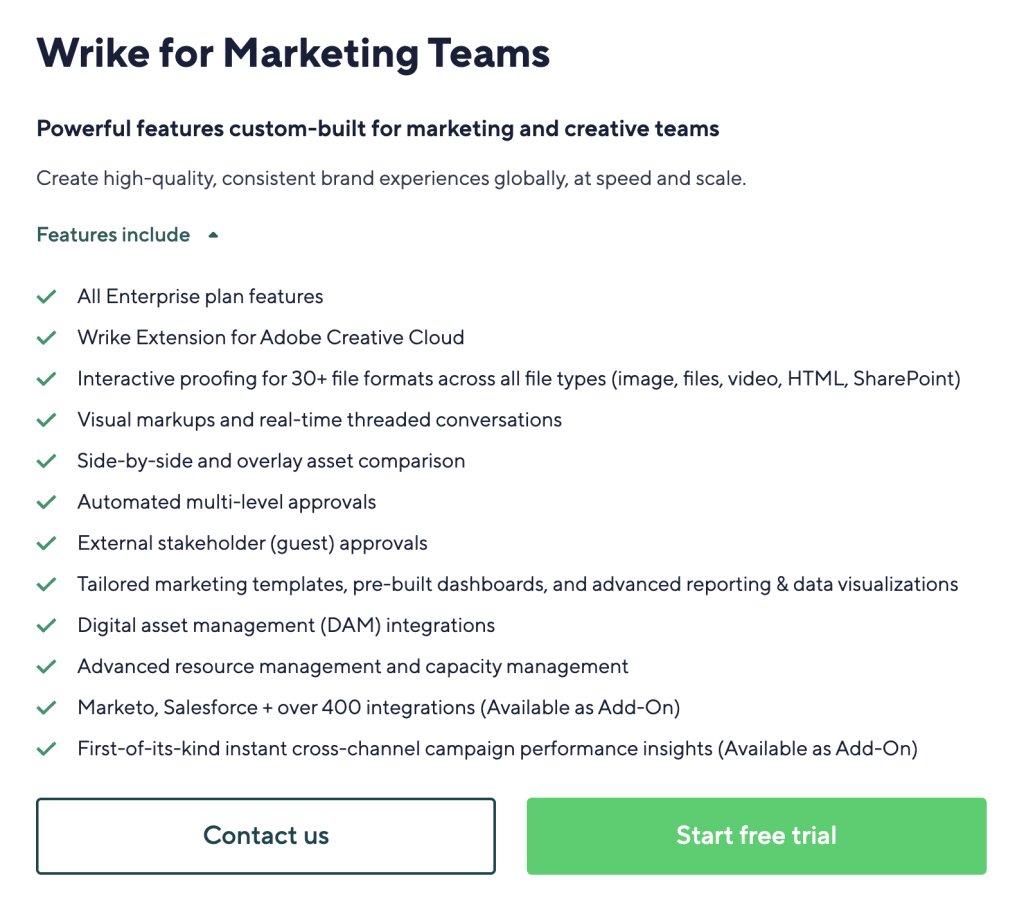
If your head’s already spinning from Wrike’s complex pricing model, I’m afraid there’s one last variable to add further confusion. The company also offers several add-on features that are also priced on application, one of which brings the advanced marketing reporting features into its software.
The Wrike Marketing Insights add-on allows you to import data from 50+ marketing tools for full campaign analysis. Live importing means you can view all of your data in real-time, analyse performance across channels and optimise everything from the same system you use to manage your campaigns.
The only downside is you get none of these features without the reporting add-on, even on the Wrike for Marketing Team plan.
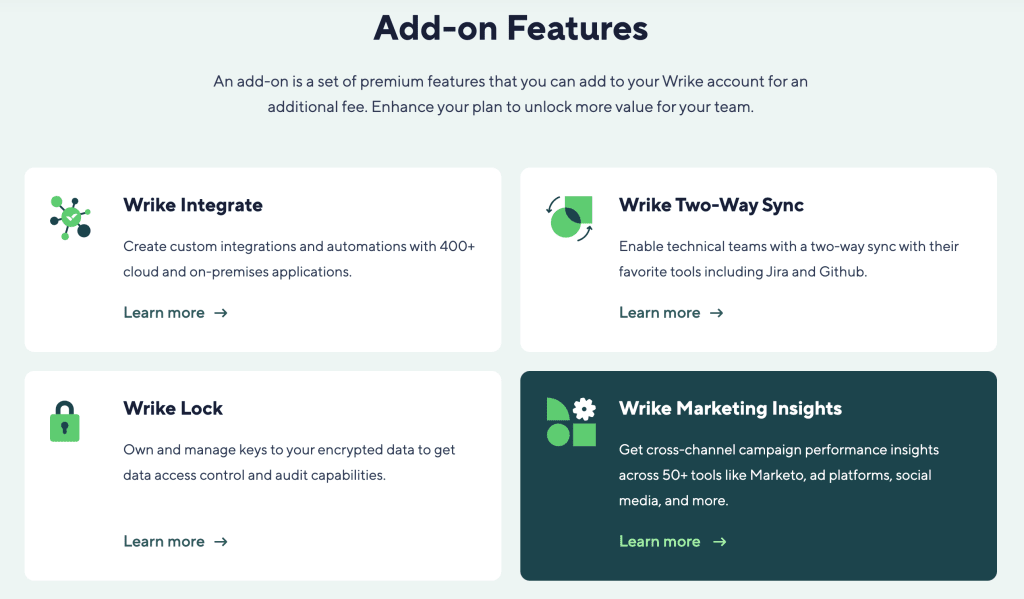
In terms of project management features, Wrike’s free plan starts off with a generous offering and the company’s paid plans are reasonably priced for smaller teams (per-user pricing can get expensive). But, if you’re interested in the marketing-specific features that double up the system as a marketing management platform, you’ll have to pay up enterprise-level software fees – so keep this in mind.
The good news is, you can create a Wrike account for free and testing out the free-forever plan will cost you nothing. You can also try the Wrike for Marketing Teams plan for 14 days using the free trial to get an idea of what you can expect for your money (I recommend getting a quote first).
Admittedly, 14 days doesn’t give you a huge amount of time to test out a comprehensive system like this but you can get a much better feel for the system if you get used to the free version first and, then, start your free trial.
What is Wrike good for?
For the rest of this Wrike review, we’re going to focus on the specialist plan for marketing teams because this is the focus of our comparison. We’re also going to assume you’re paying for the marketing insights add-on because we want to discuss the full capabilities of Wrike as a marketing management system.
If you’re willing to pay the full price for Wrike’s biggest features, you’re getting the best 2-for-1 project and marketing management system we’ve used here at Venture Harbour.
On the project management front, we don’t have any major complaints at all and the only possible concern – especially on the higher-tier plans – is the inevitable learning curve that comes with a platform as capable and customisable as this.
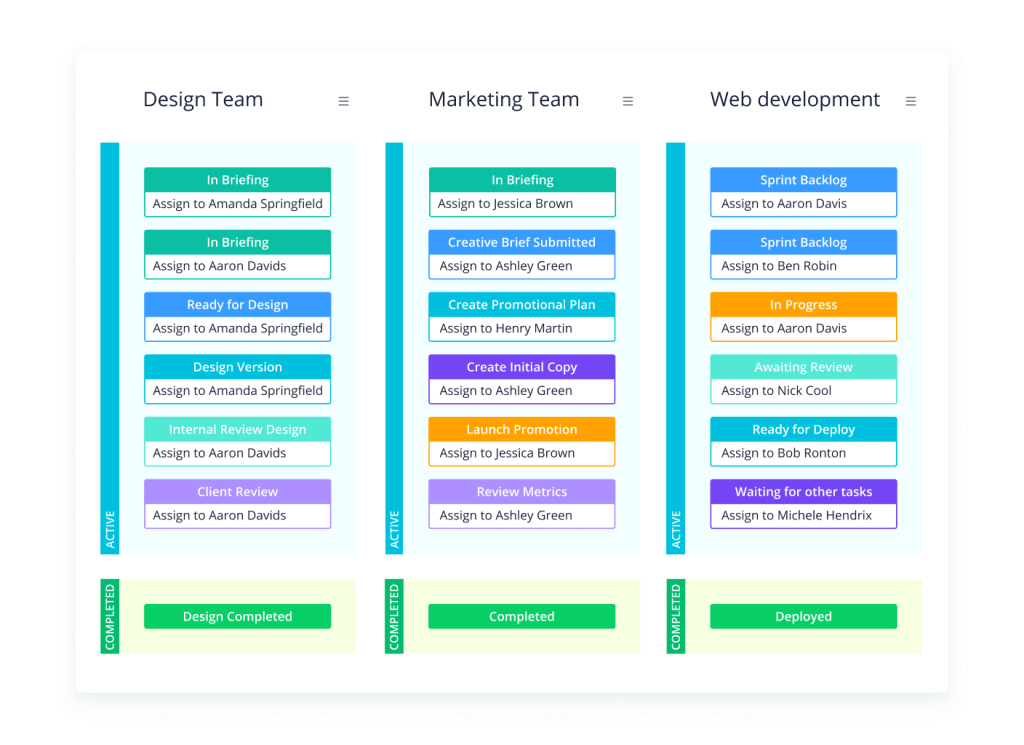
Wrike is an enterprise project management system that finds a way to provide a generous free plan and affordable entry plans that offer plenty for lower budgets. Even on the free plan, you get collaboration features, extensive control over tasks and subtasks, a live activity stream and a bunch of features normally reserved for paid plans.
At the enterprise level, Wrike continues to deliver with custom fields, custom workflows, advanced workload management and robust security features. The marketing management features are impressive with a few key missing ingredients.
What is Wrike missing?
If you’re signed up for the plan for marketing teams and the marketing insights add-on, Wrike delivers the most advanced set of marketing management features we’ve seen today – with one exception. Neither Asana, monday.com nor Infinity come close to Wrike in this regard but TrueNorth is the only platform that offers campaign management, growth projections, advanced campaign ideation features and data-driven tools for prioritising marketing actions.
Keep in mind that Wrike’s aims to be the complete project management system that also acts as a marketing management system for those who need it. However, TrueNorth is designed specifically as an advanced marketing management system that doesn’t try to offer project management features.
Wrike is as close as it gets to being the complete 2-in-1 solution but project management is its core function and it shows.
The other big issue with Wrike – at least, for marketing teams – is the complex pricing model and the lack of lower-end plans with dedicated marketing features. The fact that you have to sign up for enterprise-level plans to get the best of Wrike’s features and, then, cough up even more for the reporting add-on makes this an expensive option.
Wrike pros & cons
Wrike pros
- Features: Wrike packs plenty of project and campaign management features into its software, making it one of the most flexible tools available.
- Real-time feedback: If you need real-time updates, reporting and feedback across campaign activity and performance, Wrike’s system provides the live insights you need.
- Workload management: With real-time feedback, time tracking, collaboration and automation, you can manage team and individual workloads to maximise productivity and eliminate burnout.
Wrike cons
- Speed: Wrike’s web app can be a little sluggish at times, especially when.
- Navigation: Moving around the interface, finding features and accessing dashboards isn’t particularly intuitive and the search function isn’t much help, either.
- Learning curve: With so many features and a complex architecture, you’re looking at a steep learning curve with Wrike.
Wrike verdict
If you can stomach the complex pricing model and enterprise-grade software fees, Wrike’s plan for marketing teams and the reporting add-on make for an excellent all-in-one project/marketing management system. Yes, we would like to see lower-end plans for marketing teams but, at the same time, Wrike’s feature offering on its regular plans is so impressive that we can’t complain.
Either you’re willing to pay for the full set of marketing features or you’re not. And, if it’s the latter, you can still get one of the best project management systems around at reasonable prices (especially for smaller teams) and use it alongside a dedicated marketing management system like TrueNorth.
What is the best marketing management software?
We’ve covered a lot of information in this article to illustrate the pros and cons of each software recommendation. These are all quality options in their own right but a head-to-head comparison is the best way to determine which solution is most suitable for your needs. So, in the final section of this article, we take a look at how these software options compare in the following key categories:
- Pricing
- Marketing management features
- Usability
Where possible, we include comparison tables so you can quickly compare each software platform to get a better idea of which options are the most affordable and which ones offer the features you need.
The best option for pricing
In each mini review of our five top marketing management software recommendations, we included plenty of information about pricing. But it helps to have a quick comparison table to see how they stack up against each other and you can always go back to the mini reviews to remind yourselves about the specifics of each platform.
| Tool | Free plan? | Starting price | Top plan |
|---|---|---|---|
| TrueNorth | – | £70/mo | – |
| Asana | Yes | £9.49/mo | £20.99/mo |
| monday.com | Yes | £21/mo | £42/mo |
| Infinity | – | $149 | $2,999 |
| Wrike | Yes | $9.80/mo | $24.80* |
From the table above, you can see that three of our recommendations offer free plans in addition to several paid plans. We’ve also put the starting price you can expect to pay once you upgrade from the free plan and the top plan column shows the starting price for the most expensive plans listed on each company’s pricing page, which excludes enterprise plans without pricing info.
The two companies not offering a free plan take completely different approaches to pricing. In the case of TrueNorth, there are no plans or upgrade fees to worry about and you’re covered for unlimited users at the flat-rate price of $70/month – and you get access to all of its features.
Aside from Infinity, all of the other tools are priced on a per-user basis, which means the monthly fees are multiplied with every team member you need to provide user access – so Asana’s monthly fees for its top plan jump up to £104.95/month for five users.
The best option for marketing management features
Throughout this article, we’ve talked about the conflict between project management and marketing management. As we explained in our TrueNorth mini review, while there are plenty of project management systems available, there’s a serious lack of dedicated marketing management software. As a result, most of the recommendations in this article are primarily project management platforms that try to fill the void by offering specialist marketing features, such as campaign planning and campaign management.
This is illustrated in the following table, showing which platforms offer five key marketing management features: campaign planning, campaign management, marketing analytics, forecasting and task management.
| Tool | Campaign planning | Campaign management | Marketing analytics | Forecasting | Task management |
|---|---|---|---|---|---|
| TrueNorth | ✔ | ✔ | ✔ | ✔ | Basic |
| Asana | – | – | – | – | Advanced |
| monday.com | ✔ | ✔ | – | – | Advanced |
| Infinity | – | ✔ | ✔ | – | Advanced |
| Wrike | ✔ | ✔ | ✔ | – | Advanced |
As you would expect, the project management systems all provide advanced task management features and plenty of other features you would hope to see from these platforms. TrueNorth is the software above that provides basic task management features because it’s designed specifically as a marketing management system and it only includes the task-oriented features marketing teams need to manage their campaigns.
In contrast, TrueNorth offers extensive campaign planning, campaign management and marketing analytics features and it’s the only option that provides campaign forecasting to predict the performance of campaign ideas.
That’s not the only advanced marketing feature TrueNorth provides that the other options don’t but, at the same time, the others offer far more than task management features, too. The point of the table above is to illustrate the point that TrueNorth is the only complete marketing management software that we’re aware of while the rest are project management systems that offer a varying degree of marketing-specific features.
if you’re looking for the best marketing management system, TrueNorth is the easy choice.
On the other hand, if you’re looking for an all-in-one project and marketing management solution, options like Wrike and Infinity may provide a compromise that works for you.
The best option for usability
Usability is an important factor with any software tool and even the best feature list can feel useless when the UX of a platform makes it too difficult or unpleasant to use. Obviously, usability is a subjective quality but we can use measurable characteristics to paint a more objective picture of UX quality:
- Smooth operation: The software runs smoothly without any lags or slowdowns as you interact with elements.
- Navigation: Elements, tools, settings and everything else you interact with is easy to find.
- Minimal clicks: Simple actions require no more than 1-3 clicks to complete and more complex actions (eg: settings changes) within a reasonable number of clicks.
- Action completions: The quantity of meaningful actions you complete vs time spent interacting directly with the software.
All of the software tools in this article perform well in terms of usability but TrueNorth is the only one that specifically has usability listed as one of its biggest strengths. If you read our mini review, you might remember we discussed how the system is designed specifically for the purpose of marketing management while the other providers have to squeeze more features into their system to fill both project and marketing management roles.
As a result, the learning curve on the other systems is bigger while TrueNorth manages to deliver the more powerful set of marketing features.
The other point we discussed is that TrueNorth is designed and optimised to get out of your way. With features like meeting-less ideation and campaign forecasting, the system helps you plan, manage and optimise campaigns faster so you can invest the saved time on high-impact actions.
It’s not much help if a platform helps you complete tasks faster but you have to spend all of that saved time (or more) fiddling with settings inside the platform to complete said tasks.
This was one issue we raised with monday.com where the constant updating of task statuses, responding to comments and adapting workflows can leave you wondering if you’ve saved any time at all.
Which marketing management software is right for you?
The key takeaway from our look at the top five marketing management systems is this: if you want the best in marketing management features, TrueNorth is the clear winner. This is the only platform specifically designed for marketing management while the other options are primarily project management platforms that aim to moonlight as marketing systems to varying degrees of success.
On the other hand, if you want one system capable of doing both jobs for you, Wrike and Infinity are the first two platforms you should look at. Neither match TrueNorth as a dedicated marketing management system but they deliver flexible project management and a solid set of marketing and campaign features, even if you don’t get the campaign simulator and TrueNorth’s most advanced tools.




